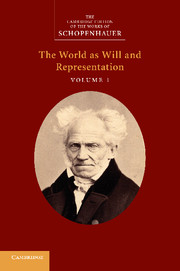Book contents
- Frontmatter
- Contents
- General editor's preface
- Editorial notes and references
- Introduction
- Notes on text and translation
- Chronology
- Bibliography
- THE WORLD AS WILL AND REPRESENTATION VOLUME 1
- Preface to the first edition
- Preface to the second edition
- Preface to the third edition
- First Book: The world as representation, first consideration. Representation subject to the principle of sufficient reason: the object of experience and science
- Second Book: The world as will, first consideration. The objectivation of the will
- Third Book: The world as representation, second consideration. Representation independent of the principle of sufficient reason: the Platonic Idea: the object of art
- Fourth Book: The world as will, second consideration. With the achievement of self-knowledge, affirmation and negation of the will to life
- Appendix: Critique of the Kantian Philosophy
- Variants in different editions
- Glossary of names
- Index
Third Book: The world as representation, second consideration. Representation independent of the principle of sufficient reason: the Platonic Idea: the object of art
Published online by Cambridge University Press: 06 December 2010
- Frontmatter
- Contents
- General editor's preface
- Editorial notes and references
- Introduction
- Notes on text and translation
- Chronology
- Bibliography
- THE WORLD AS WILL AND REPRESENTATION VOLUME 1
- Preface to the first edition
- Preface to the second edition
- Preface to the third edition
- First Book: The world as representation, first consideration. Representation subject to the principle of sufficient reason: the object of experience and science
- Second Book: The world as will, first consideration. The objectivation of the will
- Third Book: The world as representation, second consideration. Representation independent of the principle of sufficient reason: the Platonic Idea: the object of art
- Fourth Book: The world as will, second consideration. With the achievement of self-knowledge, affirmation and negation of the will to life
- Appendix: Critique of the Kantian Philosophy
- Variants in different editions
- Glossary of names
- Index
Summary
Τί τὸ ὂν μὲν ἀεὶ, γένεσιν δὲ οὐκ ἔχον; καὶ τί τὸ γιγνόμενον μὲν καὶ ἀπολλύμενον, ὄντως δὲ οὐδέποτε ὄν;
Plato[‘What is it that always is, and has no becoming; and what is it that becomes and passes away but never truly is?’ – Based on Timaeus 27d–28a]
In the First Book, the world was presented as mere representation, object for a subject; in the Second Book we considered this world from its other side and found that it is also will, and this proved to be the only thing the world is, apart from representation. In recognition of this fact we went on to name the world as representation (both as a whole and in its parts) the objecthood of the will, which accordingly means: the will become object, i.e. representation. We may further recall that such an objectivation of the will had many, albeit determinate, levels at which the essence of the will enters representation (i.e. presents itself as an object) with gradually increasing degrees of clarity and perfection. We already recognized these levels as Plato's Ideas, in so far as they are nothing but particular species, or the original, unchanging forms and qualities of all natural bodies, inorganic no less than organic, as well as the universal forces that manifest themselves according to natural laws. Taken together, these Ideas present themselves in countless individuals and details, relating to these as model to imitations.
Information
- Type
- Chapter
- Information
- Schopenhauer: 'The World as Will and Representation' , pp. 191 - 296Publisher: Cambridge University PressPrint publication year: 2010
